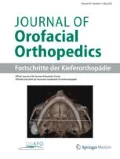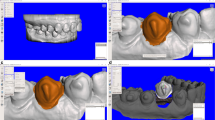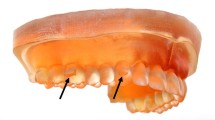Abstract
Purpose
The aims of the study were (1) to evaluate the fitting of three different aligners (Invisalign [Align Technology, Santa Clara, CA, USA], CA Clear Aligner [Scheu-Dental, Iserlohn, Germany] and F22 [Sweden&Martina, Due Carrare, Italy]) on anchorage attachments using scanning electron microscopy (SEM), and (2) to analyze the influence of 2 different types of resin used to build attachments on aligner fitting.
Methods
Using STL files of a patient, six resin casts were obtained and rectangular attachments were bonded on them. Conventional bulk-fill resin was used to build upper attachments while a flowable resin was used to build the lower ones. Passive aligners were adapted on each cast and then sectioned buccolingually. Microphotographs of the obtained sections were performed using a SEM and then micrometric measurements of aligner fitting on anchorage attachments were recorded.
Results
Analyzing the overall fitting of upper arch aligners, Invisalign provided a significantly better fitting with respect to F22 (P = 0.009); differences were not significant when comparing Invisalign with CA Clear Aligner, and CA Clear Aligner with F22. Analyzing the overall fitting of lower arch aligners, F22 provided a significantly better fitting with respect to CA Clear Aligner (P = 0.008) and Invisalign (P = 0.011). The analysis showed a significantly better fitting on upper attachments, built using conventional bulk-fill resin (P = 0.034).
Conclusions
Invisalign, CA Clear Aligner and F22 have comparable performance in terms of fitting on anchorage attachments. Conventional bulk-fill resin provides the best fitting on anchorage attachments.
Zusammenfassung
Ziel
Ziele der vorliegenden Studie waren (1) die Paßgenauigkeit von drei unterschiedlichen Alignern (Invisalign [Align Technology, Santa Clara, CA, USA], CA Clear Aligner [Scheu-Dental, Iserlohn, Germany] and F22 [Sweden&Martina, Due Carrare, Italy]) an Verankerungsattachments rasterelektronenmikroskopisch zu untersuchen (REM) und (2) den Einfluss von zwei unterschiedlichen Kompositmaterialien zum Attachmentaufbau auf die Alignerpassform zu prüfen.
Methode
Aus STL Datensätzen eines Patienten wurden sechs Modelle gedruckt und mit rechteckigen Attachments versehen. Für die Attachments im Oberkiefer wurde konventionelles Bulk-Fill Komposit verwendet, für Attachments im Unterkiefer fließfähiges Komposit. Für jedes Modell wurden passive Aligner erstellt und in bukkolingualer Richtung durchtrennt. Mikrophotographien der gewonnenen Schnitte wurden rasterelektronenmikroskopisch untersucht. Die Passform der Aligner an den Attachments wurde metrisch bestimmt.
Ergebnisse
Analysiert man die Passgenauigkeit der Aligner im Oberkiefer, zeigten Aligner von Invisalign signifikant bessere Ergebnisse als F22 Aligner (P = 0,009). Unterschiede zwischen Invisalign und CA Clear Aligner bzw. CA Clear Aligner und F22 waren statistisch nicht signifikant. Betrachtet man die Passgenauigkeit der Aligner im Unterkiefer, schnitten F22 Aligner signifikant besser als CA Clear Aligner (P = 0,008) und Invisalign ab (P = 0,011). Attachments im Oberkiefer aus konventionellem Bulk-Fill Komposit waren den Attachments im Unterkiefer signifikant überlegen (P = 0,034).
Schlussfolgerungen
Invisalign, CA Clear Aligner und F22 zeigten vergleichbare Ergebnisse in Hinblick auf die Passgenauigkeit von Alignern an Verankerungsattachments. Generell war die Passform der Aligner an Attachments aus konventionellem Bulk-Fill Komposit besser als an Attachments aus fließfähigem Komposit.




Similar content being viewed by others
References
Angle EH (1907) Treatment of malocclusion of the teeth: Angle’s system. 7th ed. Philadelphia: S.S. White dental manufacturing Co, pp 78–79
Benetti AR, Havndrup-Pedersen C, Honoré D, Pedersen MK, Pallesen U (2015) Bulk-fill resin composites: polymerization contraction, depth of cure, and gap formation. Oper Dent 40:190–200
Clelland NL, Pagnotto MP, Kerby RE, Seghi RR (2005) Relative wear of flowable and highly filled composite. J Prosthet Dent 93:153–157
Comba B, Parrini S, Rossini G, Castroflorio T, Deregibus A (2017) A Three-Dimensional Finite Element Analysis of Upper-Canine Distalization with Clear Aligners, Composite Attachments, and Class II Elastics. J Clin Orthod Jco 51:24
Dasy H, Dasy A, Asatrian G, Rózsa N, Lee H‑F, Kwak JH (2015) Effects of variable attachment shapes and aligner material on aligner retention. Angle Orthod 85:934–940
Elkholy F, Mikhaiel B, Schmidt F, Lapatki B (2017) Mechanical load exerted by PET-G aligners during mesial and distal derotation of a mandibular canineMechanische Belastung durch PET-G-Aligner bei mesialer und distaler Derotation eines mandibulären Eckzahns. J Orofac Orthop Kieferorthopädie 78:361–370
Elkholy FSF, Jäger R, Lapatki B (2017) Forces and moments applied during derotation of a maxillary central incisor with thinner aligners: An in-vitro study. Am J Orthod Dentofacial Orthop 151(2):407–415. https://doi.org/10.1016/j.ajodo.2016.08.020
Feinberg KB (2015) Translucency, stain resistance and hardness of composites used for invisalign attachments. The University of Alabama, Birmingham
Fornaini C, Lagori G, Merigo E, Rocca J, Chiusano M, Cucinotta A (2015) 405 nm diode laser, halogen lamp and LED device comparison in dental composites cure: an “in vitro” experimental trial. Laser Ther 24:265–274
Garino F, Castroflorio T, Daher S, Ravera S, Rossini G, Cugliari G, Deregibus A (2016) Effectiveness of Composite Attachments in Controlling Upper-Molar Movement with Aligners. J Clin Orthod Jco 50:341–347
Garino F, Garino GB, Castroflorio T (2014) The iTero intraoral scanner in Invisalign treatment: a two-year report. J Clin Orthod 48:98–106
Hahn W, Zapf A, Dathe H, Fialka-Fricke J, Fricke-Zech S, Gruber R, Kubein-Meesenburg D, Sadat-Khonsari R (2010) Torquing an upper central incisor with aligners—acting forces and biomechanical principles. Eur J Orthod 32:607–613
Higley L (1969) Anchorage in orthodontics. Am J Orthod 55:791–794
Kaza S (2006) Scanning process and stereolithography. The Invisalign® system. Quintessence Publishing, Surrey, UK, pp 47–54
Kuo E, Duong T (2006) Invisalign attachments: materials. The Invisalign System vol 92. Quintessence, Philadelphia, Pa
Lobiondo PE (2013) Clear-Aligner®, pp 93–106. Ripano: Clear-Aligner
Meister M, Masella RS (2005) Differential moments: An anchorage system. Am J Orthod Dentofacial Orthop 128:273–276
Ravera S, Castroflorio T, Garino F, Daher S, Cugliari G, Deregibus A (2016) Maxillary molar distalization with aligners in adult patients: a multicenter retrospective study. Prog Orthod 17:12
Roberts-Harry D, Sandy J (2004) Orthodontics. Part 9: anchorage control and distal movement. Br Dent J 196:255
Rossini G, Parrini S, Castroflorio T, Deregibus A, Debernardi CL (2014) Efficacy of clear aligners in controlling orthodontic tooth movement: a systematic review. Angle Orthod 85:881–889
Rossini G, Parrini S, Castroflorio T, Deregibus A, Debernardi CL (2016) Diagnostic accuracy and measurement sensitivity of digital models for orthodontic purposes: A systematic review. Am J Orthod Dentofacial Orthop 149:161–170
Santini A, Naaman R, Aldossary M (2017) Light energy transmission and Vickers hardness ratio of bulk-fill resin based composites at different thicknesses cured by a dual-wave or a single-wave light curing unit. Am J Dent 30:65–70
Sathy BN, Mony U, Menon D, Baskaran V, Mikos AG, Nair S (2015) Bone tissue engineering with multilayered scaffolds—Part I: an approach for vascularizing engineered constructs in vivo. Tissue Eng Part A 21:2480–2494
Satterthwaite JD, Maisuria A, Vogel K, Watts DC (2012) Effect of resin-composite filler particle size and shape on shrinkage-stress. Dent Mater 28:609–614
Satterthwaite JD, Vogel K, Watts DC (2009) Effect of resin-composite filler particle size and shape on shrinkage-strain. Dent Mater 25:1612–1615
Schneider CA, Rasband WS, Eliceiri KW (2012) NIH Image to ImageJ: 25 years of image analysis. Nat Methods 9:671
Shafiq M, Yasin T, Saeed S (2012) Synthesis and characterization of linear low‐density polyethylene/sepiolite nanocomposites. J Appl Polym Sci 123:1718–1723
Simon M, Keilig L, Schwarze J, Jung BA, Bourauel C (2014) Forces and moments generated by removable thermoplastic aligners: incisor torque, premolar derotation, and molar distalization. Am J Orthod Dentofacial Orthop 145:728–736
Simon M, Keilig L, Schwarze J, Jung BA, Bourauel C (2014) Treatment outcome and efficacy of an aligner technique—regarding incisor torque, premolar derotation and molar distalization. BMC Oral Health 14:68
Yu H, Wegehaupt FJ, Wiegand A, Roos M, Attin T, Buchalla W (2009) Erosion and abrasion of tooth-colored restorative materials and human enamel. J Dent 37:913–922
Author information
Authors and Affiliations
Corresponding author
Ethics declarations
Conflict of interest
E. Mantovani, E. Castroflorio, G. Rossini, F. Garino, G. Cugliari, A. Deregibus and T. Castroflorio declare that they have no competing interests.
Rights and permissions
About this article
Cite this article
Mantovani, E., Castroflorio, E., Rossini, G. et al. Scanning electron microscopy analysis of aligner fitting on anchorage attachments. J Orofac Orthop 80, 79–87 (2019). https://doi.org/10.1007/s00056-018-00167-1
Received:
Accepted:
Published:
Issue Date:
DOI: https://doi.org/10.1007/s00056-018-00167-1




